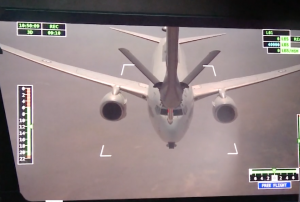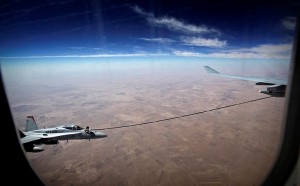2015-10-31 October 23rd 2015 was a historic day for the Royal Australian Air Force (RAAF) following the first combat refueling by a RAAF KC-30 Multirole Tanker Transport aircraft using its new-technology computerized refueling boom.
The flying boom system allows for faster transfer of fuel than the hose-and-drogue system and will allow the RAAF to refuel boom-refuelling equipped aircraft such as the C-17 Globemaster III strategic transport aircraft, the E-7A Wedgetail Airborne Early Warning and Control aircraft and the F-35 Lightning Joint Strike Fighter.
The KC-30 and E-7A operating in Iraq are serving with the Air Task Group (ATG), the RAAF’s air combat group operating within a US-led international coalition assembled to disrupt and degrade Daesh operations.
The ATG comprises six RAAF F/A-18 Hornets, an E-7A Wedgetail Airborne Early Warning and Control aircraft and a KC-30A Multi-Role Tanker Transport aircraft.
There are up to 350 personnel deployed, at any one time, to the Middle East Region as part of, or in direct support of the ATG, which is part of Australia’s broader Defence contribution to Iraq, codenamed Operation OKRA, which includes a Special Operations Task Group and a combined Australian – New Zealand training group for the Iraqi Army.
10/27/15
Credit: Australian MoD
An Update on the A330MRTT Boom: First KC-30A Wedgetail Refueling in Iraqi Skies from SldInfo.com on Vimeo.
KC-30A and Wedgetail are two pieces of kit in the Plan Jericho integrated force re-set for the Royal Australian Air Force.
Recently, the KC-30A engagement was instrumental to rescuing a USMC F-18.
In a real world warfighting perspective, the KC-30A with the crew’s battlefield awareness and operational agility has come to the aid of a UMSC F-18 over the skies of Northern Iraq.
In an Australian first, a RAAF KC-30A Multi-Role Tanker Transport has refueled a United States Marine Corps (USMC) F/A-18C Hornet with engine trouble over Iraq.
The USMC Hornet was flying a combat mission against Daesh over Northern Iraq when it was forced to shut down one of its two engines due to a mechanical issue.
Short on fuel, the Hornet requested air-to-air refueling support from the RAAF KC-30A.
A challenging feat at the best of times, air-to-air refueling with an engine-out Hornet had only ever been conducted in flight testing scenarios and never before from the RAAF aircraft over a war-zone.
The RAAF KC-30A aircraft’s captain, Squadron Leader Jamie, said the situation demanded some brainstorming and clever flying.
“The hardest part was that the Hornet couldn’t maintain the required altitude or speed that we normally refuel at due to the hostile environment over Iraq,” Squadron Leader Jamie said.
“The first option was to accept refueling at a reduced speed, lower than normally required, and refueling at that speed had never been done by me or my crew.
“The other option was to do what we call tobogganing, where we refuel while descending to allow the Hornet to gather more speed. This option would have brought us below a safe altitude, so we went with the first option.”
Squadron Leader Jamie said the USMC pilot demonstrated incredible skill and the RAAF KC-30A and USMC Hornet were able to conduct the complicated maneuver in order to enable the jet to refuel, fly out of Iraq and land safely.
“The Hornet had also dropped bombs from one of its wings, making his aircraft already less stable, which when combined with the loss of an engine, makes refueling in mid-air a real challenge.
“He did a great job in the end and it was a good feeling to help him out.
“If we hadn’t been able to assist, he would certainly have had to make a less than ideal landing in Iraq.”
The Australian Air Task Group comprises six F/A-18A Hornet aircraft, a KC-30A Multi-Role Tanker Transport and an E-7A Wedgetail airborne early warning and control aircraft.
As part of Operation OKRA they participate in close air support operations, air to air refueling and airborne command and control in Iraq and Syria as part of the international coalition formed to disrupt and degrade the Daesh threat.
And with regard to the Wedgetail, the software upgradeable C2 aircraft is looking to evolve its capabilities by working with other assets in an integrated battlespace.

One of those assets is the F-35 coming to the RAAF in the predictable future.
In an interview with the Reconnaissance Strike Group, the evolving synergies were higlighted.
Group Captain Antony Martin, Officer Commanding No 42 Wing which includes the Wedgetail squadron, provided an update on the Wedgetail and discussed the thinking about the way ahead.
“We have been in the Middle East for almost 12 months. We have flown about 1300 hours on station….
And the USAF has shown clear interest in our experience, as the AWACS is getting old and E-7 could be part of the post-AWACs transition.” The Wedgetail is doing the traditional fighter control but has encompassed a broader approach to management of combat assets within the battlespace, including ground elements as well.
The Wedgetail is working with the F-22s and in so doing is shaping tactics to work the relationship between fifth generation aircraft and a non-fighter battle management system.
“We are starting to draft a new E-7 con-ops to work with fifth generation aircraft, notably with the coming of the F-35, and shaping IP chat as a tool within the battlespace is part of the Jericho approach as well…..”
Wedgetail is largely a software upgradeable platform so ongoing spiral development with regular interaction namely from users to application engineers will be key for the future development of the capability.
And the USN is working with the RAAF with regard to the Wedgetail working with the new Hawkeye C2 aircraft as well providing both the U.S. and the Aussies with expanded reach into the battlespace.


